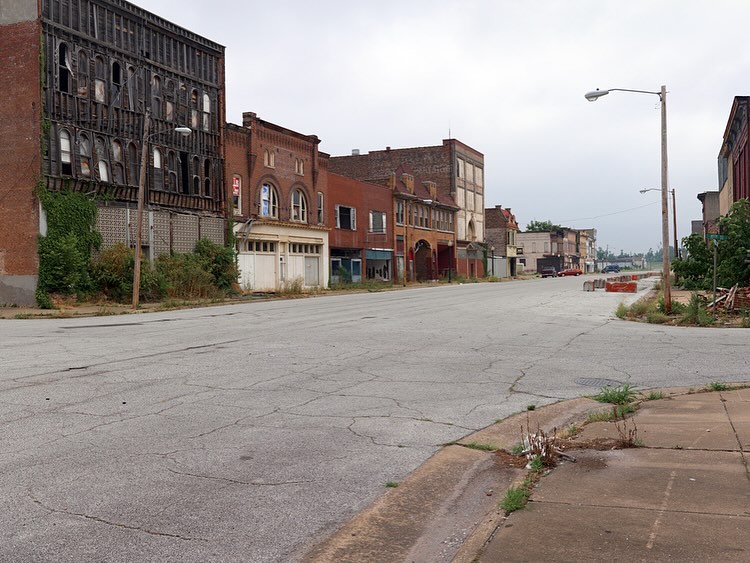Rediscovering Cairo Illinois: A Hidden Gem at the Confluence of History and Rivers
Nestled at the confluence of the mighty Mississippi and Ohio rivers, Cairo, Illinois, is a town that boasts a rich tapestry of American history, architectural marvels, and a unique geographical charm that seems almost forgotten in the hustle and bustle of modern life.
Yet, for those who take the time to explore its streets and stories, Cairo offers a fascinating glimpse into a past that shaped the nation and a present that is ripe with potential for rediscovery and rejuvenation.

Cairo Illinois: A Historical Crossroads
Cairo, pronounced “Care-oh”, has always been more than just a point on the map. Its strategic location made it a bustling hub in the 19th and early 20th centuries, attracting steamboats, railroads, and a diverse populace drawn by the promise of commerce and opportunity. This was a place where North met South, East met West, and cultures intertwined in the everyday life of its streets, markets, and waterfronts.
The city’s historical significance is further underscored by its role in the Civil War. Cairo was a vital Union stronghold, a launching pad for campaigns into the Southern heartland, and a beacon of freedom for countless enslaved African Americans who sought refuge within its borders.
The remnants of this era, including the impressive Fort Defiance Park, which offers panoramic views of the rivers’ confluence, invite visitors to step back in time and reflect on the pivotal moments that unfolded in and around Cairo.
A Brief History
The area that would become Cairo was first noted by French explorer Father Louis Hennepin in 1660, but it wasn’t until the early 19th century that attempts to settle and develop the area began in earnest. John G. Comegys, alongside Shadrach Bond, Illinois’ first governor, envisioned Cairo as a major urban center that could rival the likes of St. Louis and Cincinnati.
The city was chartered in 1818, and by the mid-1800s, with the completion of the Illinois Central Railroad, Cairo was booming as a vital transport and trade hub.
Civil War Strategic Importance
Cairo’s strategic location made it a key military asset during the Civil War. Serving as a Union stronghold, it was a supply base, training center, and a crucial point for control over the southern rivers. This period also marked the beginning of Cairo’s role as a significant site on the Underground Railroad, offering a path to freedom for many enslaved African Americans.
Post-War Prosperity and Decline
Following the Civil War, Cairo enjoyed a period of prosperity, buoyed by its status as a bustling river port and railroad hub. The city’s population grew, and its architectural landscape flourished. However, this growth was not to last.
Economic downturns, natural disasters, and a shift in transportation dynamics began to erode Cairo’s prominence. The construction of bridges and the emergence of other transportation routes diminished Cairo’s role as a critical transit point.
Racial Tensions and Civil Rights Struggles
The 20th century brought to the forefront the deep-seated racial tensions that had been simmering in Cairo. Despite the city’s significance as a site of freedom during the Civil War, Cairo was not immune to the racial strife that gripped much of America.
The mid-20th century saw Cairo become a battleground for civil rights, with the African American community fighting against segregation and for equality. This struggle was marked by boycotts, protests, and violence, leading to a significant impact on the city’s social and economic fabric.
Architectural Wonders in Decline and Hope for Revival
Walking through Cairo today, one cannot help but be struck by the architectural grandeur that once defined its skyline. The city is a living museum of historic buildings, from ornate Victorian homes to the once-grandiose Custom House, which now serves as a museum.
These structures tell the story of a bygone era of prosperity and ambition, but they also speak to the challenges Cairo has faced in terms of economic decline and population loss.
Yet, it is precisely this sense of faded glory that makes Cairo so compelling. There is a beauty in the decay, a reminder of the cyclical nature of history, and a hope that renewal is possible. Efforts to preserve Cairo’s heritage are underway, driven by both residents and outside enthusiasts who see the potential for revitalization.

“Is Cairo, Illinois a ghost town?”
Cairo, Illinois, often captures the imagination with its rich history and tales of decline, leading some to wonder if it has become a ghost town. While Cairo has experienced significant population loss and economic challenges, leading to abandoned buildings and a sense of faded glory, it does not fit the strict definition of a ghost town.
Today, Cairo stands as a city deeply marked by its history. The once-bustling Commercial Avenue, the grand mansions of Millionaires’ Row, and the historic buildings that dot the landscape speak to a past filled with both glory and turmoil. The population has dwindled, and many buildings have been abandoned or demolished, leading some to describe Cairo as a “ghost town.”
Unlike true ghost towns, which are completely abandoned with no remaining inhabitants, Cairo still has residents and a functioning community, albeit much smaller than in its heyday. The term “ghost town” conjures images of deserted streets and buildings with no sign of life, which doesn’t accurately describe Cairo.
The city’s historical significance, its architectural remnants, and its geographical uniqueness at the confluence of the Mississippi and Ohio rivers continue to attract attention. Efforts to preserve its heritage and potential for revitalization reflect hope and determination to redefine Cairo’s future.
These initiatives aim not only to save the physical buildings but to breathe new life into the community, attracting tourists, artists, and entrepreneurs drawn by the city’s unique character and strategic location.

Fort Defiance State Park
The state park near Cairo, Illinois, that often captures attention is Fort Defiance Park, also known as Fort Defiance State Park. This park is important not only for its natural beauty but also for its historical importance.
Located at the southernmost tip of Illinois, it marks the confluence of the mighty Mississippi and Ohio rivers, offering visitors a unique vantage point where they can see the waters of these two great rivers merge.
Historical Significance
Fort Defiance Park stands on the grounds of what was once a military fortification during the Civil War. The fort, originally named Fort Defiance, played a crucial role in the Union’s strategic operations in the Western Theater. It served as a key naval and army base for controlling the rivers, which were vital for supply lines and troop movements.
The fort’s location made it a significant asset for the Union forces, allowing them to dominate the southern rivers and contributing to their control over the Mississippi River and its tributaries.
Park Features
Today, Fort Defiance Park is a peaceful area that offers visitors a chance to connect with nature and history. The park provides:
- Scenic Views: The confluence of the Mississippi and Ohio rivers can be observed from the park, offering stunning views, especially at sunrise and sunset.
- Walking Trails: There are trails for visitors to explore, allowing for leisurely walks along the riverbanks.
- Picnic Areas: Families and groups can enjoy picnicking in designated areas, making it a perfect spot for a day out.
- Bird Watching: The park’s location makes it an excellent spot for bird watching, especially during migration seasons.
- Historical Markers: Informational signs and markers provide insights into the area’s significance during the Civil War and its historical context.

More to Explore Near Cairo Illinois
Exploring the area around Cairo, Illinois, offers a variety of activities and attractions that cater to history buffs, nature enthusiasts, and those looking to enjoy the scenic beauty and cultural heritage of the region. Here are some notable destinations and activities to consider:
Horseshoe Lake State Fish & Wildlife Area
Located near Olive Branch, Horseshoe Lake is a short drive from Cairo. This natural area is ideal for bird watching, fishing, and boating. The lake is one of the largest natural lakes in Illinois and provides a serene environment for outdoor activities.
Columbus-Belmont State Park
Across the Mississippi River in Kentucky, Columbus-Belmont State Park is a site of historical significance from the Civil War, offering a unique blend of history, nature, and recreation. The park features a museum, a Confederate earthwork, and beautiful views of the Mississippi River. It’s a great spot for hiking, picnicking, and learning about the strategic importance of the area during the Civil War.
Shawnee National Forest
A bit further afield, Shawnee National Forest spans across the southern tip of Illinois and offers a vast playground for nature lovers. With its diverse landscape of rolling hills, forests, and rugged bluffs, the forest is home to the famous Garden of the Gods, which offers breathtaking views and unique geological formations. Hiking, camping, horseback riding, and bird watching are popular activities here.
Mississippi River Scenic Byway
Driving along the Great River Road (Mississippi River Scenic Byway) near Cairo can be a delightful experience. This route offers picturesque views of the Mississippi River, charming small towns, and opportunities to stop at various historical and natural sites along the way.
Southern Illinois Wine Trail
For those interested in exploring local flavors, the Southern Illinois Wine Trail features several wineries that offer tastings and tours. The trail winds through the beautiful landscapes of Southern Illinois, providing a taste of the region’s agricultural and culinary heritage.

Cache River State Natural Area
A nature reserve that showcases the beauty of Illinois’s wetlands, the Cache River State Natural Area is a haven for wildlife and offers serene landscapes. It’s an excellent spot for canoeing, kayaking, bird watching, and hiking, with trails that meander through cypress swamps and floodplain forests.
Fort Massac State Park
Located in Metropolis, Illinois, Fort Massac State Park is another historical site with roots in the early American and Civil War periods. The park has a replica of the original fort, a visitor center with exhibits, and offers recreational activities such as hiking, fishing, and picnicking.
Metropolis, Illinois
Known as the “Home of Superman,” Metropolis is just a short drive from Cairo and offers a quirky and fun detour. Visitors can see the giant Superman statue, visit the Super Museum, and explore the town’s Superman-themed attractions.
These destinations and activities offer a glimpse into the rich tapestry of natural beauty, history, and culture that surrounds Cairo, Illinois. Whether you’re looking for outdoor adventure, historical exploration, or simply a peaceful retreat into nature, the region has something to offer for every type of traveler.

A Call to Explore and Rediscover
Cairo, Illinois, is a testament to the enduring spirit of American towns that have weathered the storms of change and emerged with their identity intact, albeit transformed. It is a destination that offers more than just historical landmarks; it is a place where the past and present converge, inviting visitors to explore, reflect, and imagine the possibilities of what could be.
Cairo presents an unparalleled opportunity to dive into an often-overlooked part of America. Whether it’s capturing the haunting beauty of its historic buildings, kayaking at the confluence of two great rivers, or engaging with the community to learn about their vision for the future, Cairo is a hidden gem waiting to be rediscovered.
In a world that often feels saturated with the same tourist destinations, Cairo, Illinois, stands out as a reminder of the roads less traveled. It beckons to those seeking authenticity, depth, and a connection to a story that is still unfolding. So, why not take the road to Cairo? You might just find that this hidden gem has been waiting to reveal its treasures to those willing to look beyond the surface.
This article was originally published by Ashley Pichea – Rooted Wanderings




